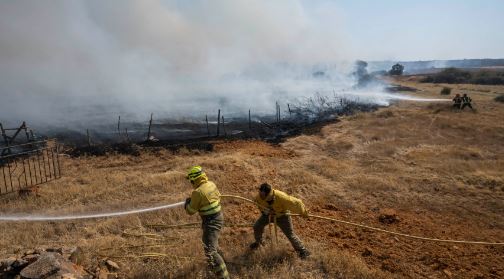- Wednesday, 21 January 2026
With record heat and drought, Spain’s Catalonia faces perfect wildfire conditions
Solsona, June 26: Surveying the hills covered with near bone-dry pines stretching to the Pyrenees in the distance, Asier Larrañaga has reason to be on guard.
This part of northeast Spain is, like large swaths of the Mediterranean country, braced for wildfires due to the lethal combination of a prolonged drought, record-high temperatures and increasingly dense woods unable to adapt to a fast-changing climate.
Larrañaga is one of the top fire analysts for the firefighters of Catalonia charged with safeguarding the region's homes and landscapes. While grateful that some desperately needed rain has finally fallen in recent weeks, he is ready for the worst — unless July and August buck Spain’s historic trend of being the hottest and driest months of the year.
“If we have a normal summer … and conditions of low humidity combined with high temperatures, then we will see fires that quickly expand beyond our extinction capacity. And for areas where it has not rained in May and this month, we could see these types of fires as early as next week,” Larrañaga told The Associated Press in the rural town of Solsona, some two hours north of Barcelona.
Spain suffered the biggest losses from wildfires of any European Union country last year amid a record-hot 2022. Four people, including one firefighter, died in blazes that consumed 306,000 hectares. And with Spain sweltering under a record-hot spring, it is again leading the continent in 2023 with 66,000 hectares turned to ashes. Now firefighters like Larrañaga across Spain are preparing for a potential scorcher of a summer.
The fires coincide with Catalonia and a large part of Spain’s south bearing the brunt of a drought that started last year and has only recently been somewhat alleviated by rain.
The central reservoirs for Catalonia, which provide water for some six million people including Barcelona, are still only at 29% of capacity and water restrictions remain in place.
Climate change is playing a direct role in propagating these fires, experts agree. The increasing temperatures have made the plants that are used to more mild weather vulnerable to both plagues and fire. Spain, like the rest of the Mediterranean, is forecast to heat up faster than the global average. Spain saw fires that showed the virulence of a summer outbreak break out as early as March.
Northern Europe is also battling blazes spurred by drought.
The 52-year-old Larrañaga is a member of Catalonia’s GRAF, its elite wildfire fighting unit.
Members of the Catalan firefighters are currently helping in Canada as part of a Spanish contingent sent to combat the massive fires that have sent smoke over the United States and as far as Europe.
Larrañaga was in Solsona to oversee a training session by the local fire brigade. Practice included simulating a last-resort protection manoeuvre used in cases when firefighters are trapped by the flames.
They clear an area of vegetation and take refuge in their truck, which is equipped with sprinklers. The firefighters said that they hope it is a manoeuvre they will never have to use.
The Solsonès county, home to Solsona and its 9,000 residents, does not normally have large fires thanks to storms generated by the Pyrenees. But the downside is that its forests build up vegetation, or “fuel” for potential fires, that become vulnerable to a lightning strike, a spark from farm machinery, or arson. (AP)



-original-thumb.jpg)













